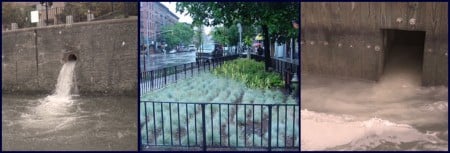Riverkeeper: Agreement to reduce sewage pollution in NYC is a good start

View more images on our Flickr site
New York City will soon be breaking ground on efforts to reduce sewage pollution thanks to a new agreement between city and state leaders that Riverkeeper and our partners helped shape.
The enforcement order agreed to by the New York State Department of Environmental Conservation and the New York City Department of Environmental Protection will lead to $187 million in spending over the next three years, and $2.4 billion over 18 years to reduce the flow of sewage into the Hudson River, East River, Newtown Creek, Gowanus Canal and other city waterways. The order reflects Riverkeeper’s goals of prioritizing significant reductions in the overall flow of sewage, citizen enforcement provisions under existing clean water laws and investments in green infrastructure that reduce the flow of stormwater that overwhelms sewer systems.
Riverkeeper is committed to actively working with city, state, and community groups to address chronic pollution and attain the Clean Water Act’s goals of fishable, swimmable waters for the Hudson River and New York Harbor.
Since 2007, Riverkeeper has played a lead role in advocating for the increased use of green infrastructure through:
- the release of our Sustainable Raindrops report;
- a federally funded effort to design and build a pilot project on a public playground in Brooklyn; and
- the founding of and participation in the Storm Water Infrastructure Matters (SWIM) Coalition, a diverse coalition of environmental groups, practitioners and community groups advocating for maximizing the use of green infrastructure in New York City.
Combined sewage overflow (CSO) systems like those that serve New York City discharge sewage along with rain water and runoff during many storms. Currently more than 27 billion gallons of raw sewage and polluted stormwater discharge out of 460 CSOs into New York Harbor each year. By 2030, discharges from city CSOs should be reduced by 1.5 billion thanks to cost-effective green infrastructure improvements alone.
Examples of green infrastructure projects include rebuilding roofs with vegetation (green roofs); porous pavement for parking lots that allows water to seep into the ground rather than run off into storm drains; and residential rain barrels that capture rain water for use in irrigating landscaping. By treating stormwater as a resource rather than a waste, we can reduce water pollution and ‘green’ urban areas, thereby improving the health of the marine ecosystem that surrounds New York City and dramatically improving the quality of life for millions of New Yorkers.

